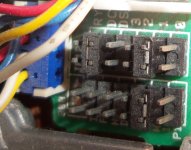Hi and thank You for reply in advance
I have an YD-701B-6031B floppy drive(sadly no manual for it, if You have a manual/service please share) - and according to similar drives manual on Internet I guess that jumper 300 is not the speed of the drive(like in case of 5,25 probably) but it is the speed of data transmission. As it is a HD 3,5 floppy drive I am trying to find/know more:
1) Does this mean that e.g. in case of reading HD floppy disks it will lower to 300 instead of 500?
2) If yes - would it work(e.g. read HD floppies) with some "vintage" controllers - like that in Amiga, or even first used in IBM 5150/similar?
I have an YD-701B-6031B floppy drive(sadly no manual for it, if You have a manual/service please share) - and according to similar drives manual on Internet I guess that jumper 300 is not the speed of the drive(like in case of 5,25 probably) but it is the speed of data transmission. As it is a HD 3,5 floppy drive I am trying to find/know more:
1) Does this mean that e.g. in case of reading HD floppy disks it will lower to 300 instead of 500?
2) If yes - would it work(e.g. read HD floppies) with some "vintage" controllers - like that in Amiga, or even first used in IBM 5150/similar?


